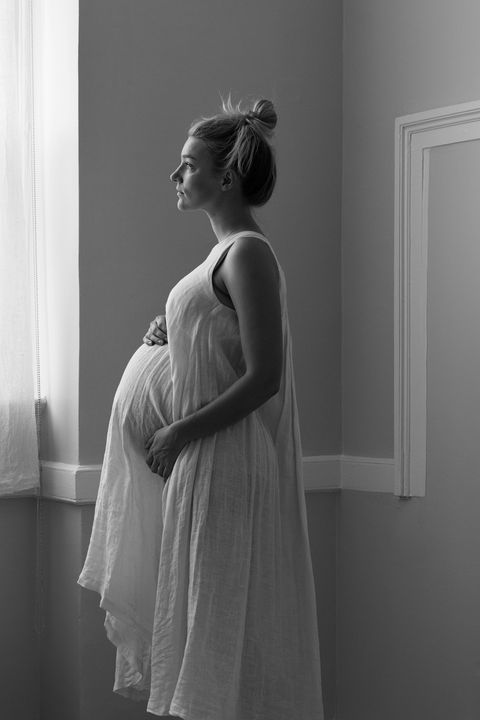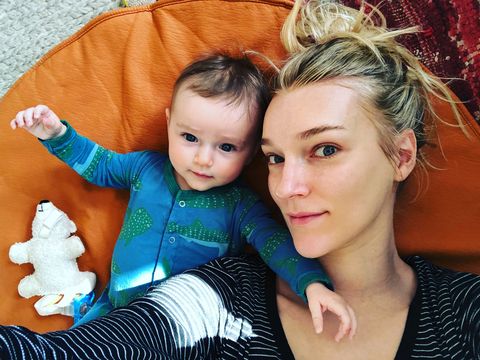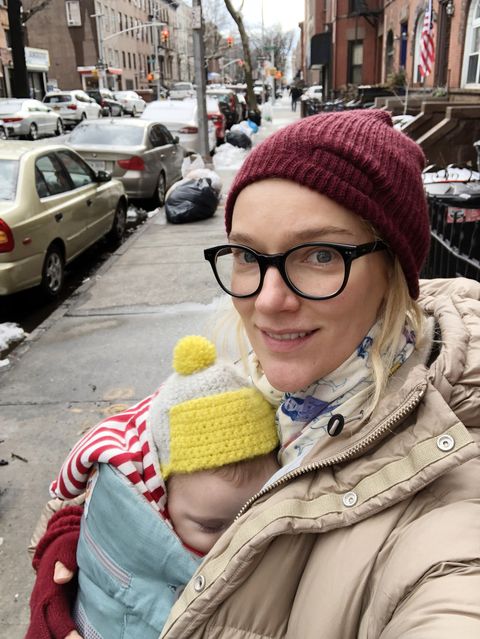The night I gave birth, I felt myself split into two distinct selves.
As my pelvis submitted to a pain akin to medieval torture, my chest finally received the weight of my daughter, who, immediately upon contact, began to nurse contentedly. After 36 hours of labor and five hours of pushing, I had sustained a severe birth injury: a 4th degree perineal laceration, which means that the skin from my vagina to my anal sphincter had ripped apart when my daughter was pulled from my body. It took two surgeons 90 minutes to stitch me back together. I was conscious the entire time.
But let’s back up a little bit.
When I was pregnant, I read all the books and listened to all the podcasts. I devoured the holistic, earthy advice right alongside the no-nonsense data-driven studies. I binged some 150 hours of childbirth stories on The Birth Hour, a podcast where women recount their experiences on everything from at-home births in inflatable tubs to emergency c-sections to laboring in the backseat of a car (not as rare as you’d hope). I listened intently, trying to envision my own childbirth experience. But eventually, I realized no matter how much I prepared, birth would be a highly unpredictable event.

Ultimately I opted for fairly conventional circumstances: I planned for my daughter to be born in a hospital under the care of an OB-GYN, and though I would accept the aid of an epidural, I wanted to avoid unnecessary medical intervention (like a c-section or a vacuum-assisted vaginal delivery). I interviewed several doctors in search of someone with a warm, un-rushed bedside manner. I also asked for their “c-section rates” (what percentage of their patients underwent emergency cesareans). While I intended to have a vaginal birth, I was aware the need for a c-section might arise—after all, c-sections are one of the most common surgeries in the U.S., accounting for 25.8 percent of first-time, low-risk births in 2015. However not all c-sections are created equal. Sometimes they are performed for the wrong reasons (as an expectant mother, I’d become attuned to whispers that OB-GYNs can be a little too willing to perform the surgery, which can take as little as 20 minutes, rather than wait out a long labor), and they can cause complications like infection, adhesions, or hemorrhaging for the mother (not to mention babies born via cesarean have a greater risk for respiratory issues in the short term). The OB-GYN I chose had a low c-section rate. She seemed friendly and pragmatic. I felt like I’d be in capable hands.
During my first trimester, I also started working with an experienced birth doula whose reassuring demeanor put me at ease. My husband and I initially balked at the idea of inviting a relative stranger into such an intimate moment in our lives, but I was intrigued. Unlike an OB-GYN, who checks on you sporadically at the hospital and who may not be present at all if she or he is not “on call” that day, a doula is all but guaranteed to be in the room with you while you labor. Not only would a doula offer support during the birth itself, our doula’s services also included 24/7 availability by phone and text, both before and after the birth. We discussed everything from the downsides of castor oil at-home inductions, to how to decide when to leave for the hospital. On her recommendation, my husband and I also arranged for a postpartum doula to come to our apartment for several days of support once the baby arrived. By the time I went into labor two days before my due date, I felt ready.
But soon after we arrived at the hospital, it became obvious this was not going to be an easy birth. The anesthesiologist seemed impatient with my intense fear of needles as he administered the epidural. By noon the next day, my cervix fully dilated at 10 cm, my doctor declared me ready to begin pushing despite the fact I wasn’t experiencing “the urge” to push, which supposedly felt like you had to take the biggest poop of your life.
“Something didn’t feel right; I couldn’t feel the weight of my baby to push against.”
The pain came back with renewed intensity. In order to feel the pressure of the baby, and to push more effectively downwards against her, the epidural was turned down and an overwhelming pressure coursed through my pelvis in waves so acute I vomited between contractions. Something didn’t feel right; I couldn’t feel the weight of my baby to push against. After about an hour, exhausted, I could tell I had made little progress. According to the monitors attached to my belly, my baby was still doing just fine, but she was showing no interest in moving closer to the open air of the hospital room. For the first time that day, I asked my doctor about the possibility of a c-section. She told me to keep bearing down, projecting the focus of a high school football coach on gameday. My doula was gentler, telling me when I had given a particularly effective push and giving me images to help me visualize the baby descending.
After 90 minutes of what felt like fruitless effort, my OB called a time out and cranked the epidural back up. I was told to rest.

Finally, four hours later, I felt the unmistakable urge. With a renewed sense of optimism—maybe this was it!—I began pushing, but something still did not feel right, and again, I asked my OB-GYN about a c-section. I felt like I was drowning in the pain. Each contraction came as a wave crashing down on me and I could barely come up for air before I felt the next one swallowing me up. At this point I’d been in labor for 34 hours. Through two more hours of pushing, I requested a c-section at least three times, but each time my OB responded, “Give me 30 more minutes of pushing…five more good pushes…two more…” Her coaching implied that an end was in sight, but my body seemed to disagree. At one point between contractions I looked her dead in the eye—her face was visible between my knees—and calmly and directly requested a caesarean. She didn’t respond, and then the next contraction was upon me.
“Her coaching implied that an end was in sight, but my body seemed to disagree.”
(It’s worth noting that while doulas are commonly thought of as “advocates” for their clients during birth, it would have been inappropriate for my doula, who was holding one of my feet at the time—or my husband for that matter, who was at my side—to get between a doctor and patient.)
Eventually, my doctor reported that my daughter’s head was visible. She wanted to do a vacuum extraction. Things moved very quickly; I didn’t have a chance to ask questions. Using a special vacuum that suctioned to the baby’s head, she pulled my baby out in two contractions, and my body tore from front to back in the process.
THE TRUTH ABOUT TEARING
The acute pain of “crowning” is legendary. Known as “the ring of fire,” the moment the baby’s head emerges is accompanied by a searing pain unlike any other. The sensation of my daughter exiting my own body felt mortal. It was my doula who, as the nurses ferried my healthy, wailing newborn across the room to check her vitals, explained to me that I had a 4th degree tear.
Vaginal tears, or perineal lacerations, are a common result of vaginal deliveries. They occur when the baby emerges from the vaginal opening. The severity of the tears is measured in degrees, ranging from common 1st and 2nd degree (minor cuts or abrasions) to severe 3rd and 4th degree (deep lacerations to muscles and tissue). Though most women who give birth vaginally will tear to some degree, there is little agreement about the incidence rate for 3rd and 4th degree lacerations. A study published in the official journal of the American College of Obstetricians and Gynecology estimates that more than 3 percent of vaginal deliveries incur a 3rd degree tear, and just over 1 percent incur a 4th degree tear. However, further studies suggest the incidence rate for severe tears to be as high as 11 percent.
“Many American women don’t realize that childbirth can involve such extreme injury.”
Many American women don’t realize that childbirth can involve such extreme injury. When Chrissy Teigen revealed on Twitter recently that the birth of her first child had resulted in a tear, repaired with many stitches, people responded in bewilderment. “What are the stitches for? I thought they only used stitches in c-sections?” one commenter wrote. Teigen responded, “lol bless you this is so cute.”
I can confirm postpartum life is 90% better when you don’t rip to your butthole. Baby boy: 1 point. Luna: 0
Truthfully, it took me weeks to fully comprehend the severity of my own injury. After two nights at the hospital, my OB-GYN sent me home with stool softeners and a prescription for Percocet for the pain. The doctor told me to return to see her in six weeks—the standard level of care for most postpartum mothers.
The first few weeks of my daughter’s life are hazy, as they are for most new parents. Memories of that time come in fragments: the feeling of her tiny body curled against my chest as she slept, while I was in such excruciating pain I couldn’t stand or sit; waking up soaked in sweat and breast milk; feeling light-headed in the shower, hoping I wouldn’t lose consciousness from the pain but determined to wash myself; the delicious sensation of oxytocin—the love hormone—flooding my brain as I stared down at my daughter while we nursed; discovering for the first time that she has dimples when she smiles.
I also felt a profound sense of mystery about my injury. What did it look like? How had I been repaired? It wasn’t until six weeks after giving birth, at my postpartum doula’s encouragement, that I finally used a hand mirror to look between my legs. I remember being relieved at what I saw–my imagination had yielded far worse than reality. At least superficially, my body looked much more normal than I’d anticipated. Still, I could barely walk around my apartment or do the dishes without being sore for days afterwards.
“I finally used a hand mirror to look between my legs. I remember being relieved at what I saw.”
My birth doula likened the surgical repair for a 4th degree tear to an intricate embroidery of many layers of tissue and muscle, a repair that heals from the inside out to bring back the integral components of the pelvic floor musculature. Most of the healing, she said, was not visible to the naked eye.
Nonetheless, my recovery was neither easy nor swift: I was in diapers for three weeks, largely bedridden for the better part of six, and homebound for three months postpartum. I wasn’t able to stand up holding my baby, let alone carry or “wear” her in a baby carrier for months. My husband changed most of those early diapers himself, while I watched from bed, both grateful and envious.

All I could do was breastfeed—which, thanks to luck and my postpartum doula, went smoothly. I was on alternating doses of over-the-counter painkillers, supplemented by Percocet for the first few weeks. Despite the doctor’s assurances that the dosage was small enough to be negligible, I worried about the drugs being present in my breast milk, but without them, I could not function. Every few weeks, I would venture outside for brief walks around the block to test myself.
After two and a half months of prescribed rest, I knew I needed something more. My birth doula recommended I consult a colorectal surgeon, who, after expressing dismay at the way I had been tending to my wound, gave me instructions for caring for it properly. I soon noticed an almost immediate change in the way I felt, and after two more appointments with him, he performed two additional procedures to close tiny gaps in the stitches.
“I was in diapers for three weeks, largely bedridden for the better part of six, and homebound for three months postpartum.”
At a certain point, pain from the wound had faded, but my undercarriage felt like it was made of lace, unable to bear the weight straining against it from above. My pelvic floor—anchored by the perineum, the space between your vagina and rectum, where about 16 muscles meet—was extremely weak and required physical therapy. Lindsey Vestal, founder of The Functional Pelvis, explains that this “Grand Central” of the body needs to be resilient, and capable of a full range of motion, to facilitate “elimination, organ support, and sexual pleasure.” No amount of Kegel-ing will ensure a strong pelvic floor, I learned: “Most women automatically assume that blindly doing kegels over and over will fix their leaky bladder, back pain, or discomfort during sex. This just isn’t the case,” says Vestal. Instead, pelvic floor therapy addresses the myriad issues associated with pelvic health, and thankfully, an increasing number of American OB-GYNs are prescribing it for their postpartum clients.
Finally, four months after giving birth, my specialist declared me healed: cleared for exercise and sex. My job as a photographer is quite physical (carrying cameras and heavy equipment, staying on my feet for the better part of a day to produce a shot, and moving around to capture the best frame), and I’d had to put it all on hold; unable to sit comfortably, much less stand. Now I was finally able to get back to work. Most women who give birth vaginally are physically cleared at six weeks, women who undergo c-sections typically six to eight weeks. It took me double that time.
THE IMPORTANCE OF POSTPARTUM CARE
I consider myself extremely lucky. Some women who withstand 4th degree tears face long-term incontinence and are at risk of developing a recto-vaginal fistula (a tunnel that develops between the rectum and vagina causing stool and gas to leak through the vaginal opening), as well as pelvic organ prolapse (when the uterus or bladder protrudes out of the vagina), and a plethora of other complications that can affect their ability to have normal bodily function.
Though I’ve fully healed from my injury, I’m still traumatized by my birth. My colorectal surgeon alluded to the possibility of postpartum PTSD, something that affects about 9 percent of women after childbirth. “It is far more common than most people realize,” Nan Strauss, Director of Policy and Advocacy for Every Mother Counts, tells me. To make postpartum PTSD less likely or less severe, Strauss stresses the importance of making sure women are always informed about—and engaged in—decision-making about their own care. Facilitating access to the kind of emotional support that doulas provide during childbirth is also important.
“Though I’ve fully healed from my injury, I’m still traumatized by my birth.”
Not only was my birth doula a critical source of information to me, she and our postpartum doula cared for my family in ways I would never have expected. They taught me how to breastfeed in positions that were comfortable, how to use a sitz bath, treat sore nipples, and use my breast pump, not to mention how to expertly swaddle our daughter and how to burp and soothe her. Our postpartum doula was also there for me emotionally—with all the hormones coursing through my battered body, my nerves were frayed, and it helped a lot to talk. Nothing scared these women. They were fully present; their care was genuine and unwavering, which vaporized much of the anxiety of those early days. They prioritized the well-being of our entire family, not just our daughter’s, which allowed us to bond deeply with her.

I’ve spent hours replaying my labor, trying to understand where things went wrong. Were there telltale signs that I needed a c-section? What could have happened differently for me? While I’m far from the first woman who, in the throes of labor, has asked for a cesarean, I do wish there had been more discussion of my options and of what had happened when my daughter came out. Perhaps the outcome was inevitable, a result of circumstances that no amount of good decision-making could have prevented. Perhaps not.
Still, no matter how they fare in childbirth, postpartum women are given astonishingly inadequate care. Obstetrics is more focused on the well-being of the baby than the mother. Add to that the fact that women of color, particularly black women, have much higher rates of birth complications, as well as higher infant and maternal mortality rates (this is true across class, as exemplified by Serena Williams’ recent traumatic birth). It has become clear that we need to reform the way the medical establishment treats pre and postnatal women. As a recent New York Times article suggests, doula support—the average cost of which is anywhere between $300 to $1,200, with many paying much more—shouldn’t be something that only a privileged few benefit from. It should be a service covered by medical insurance.
“No matter how they fare in childbirth, postpartum women are given astonishingly inadequate care.”
Fortunately, the importance of doulas is slowly gaining wider recognition. New York Governor Andrew Cuomo recently announced an initiative to include Medicaid coverage for doula support. (Minnesota and Oregon already do.) Some doulas also offer their services on a sliding scale or volunteer basis, particularly if they are still in training, and there are organizations that help match women with doulas, like DONA International, toLabor, and Childbirth International.
It is undoubtably important to build support in advance of your birth for you and your family. Choosing a care provider who is an excellent listener and communicator is as fundamental as knowing how they will work with you to make decisions in hypothetical situations. And while it’s wise to educate yourself about birth, keep an open mind about how it will unfold. Bringing a three-page ironclad “birth plan” to the hospital may only lead to disappointment (and annoy the nurses). Formulate goals (“a vaginal birth”) rather than rules (“no interventions whatsoever, including painkillers”) and above all, be prepared to be flexible. You may change your mind, and that’s alright. Birth, which has been described as affirming, beautiful, even orgasmic by some women, can also be traumatic. There is no telling where the chips will fall, and ultimately, the best gift we can give new mothers isn’t a diaper cake—it’s the right to be listened to, and to be cared for.
From: Harper's BAZAAR US
Source: Read Full Article
